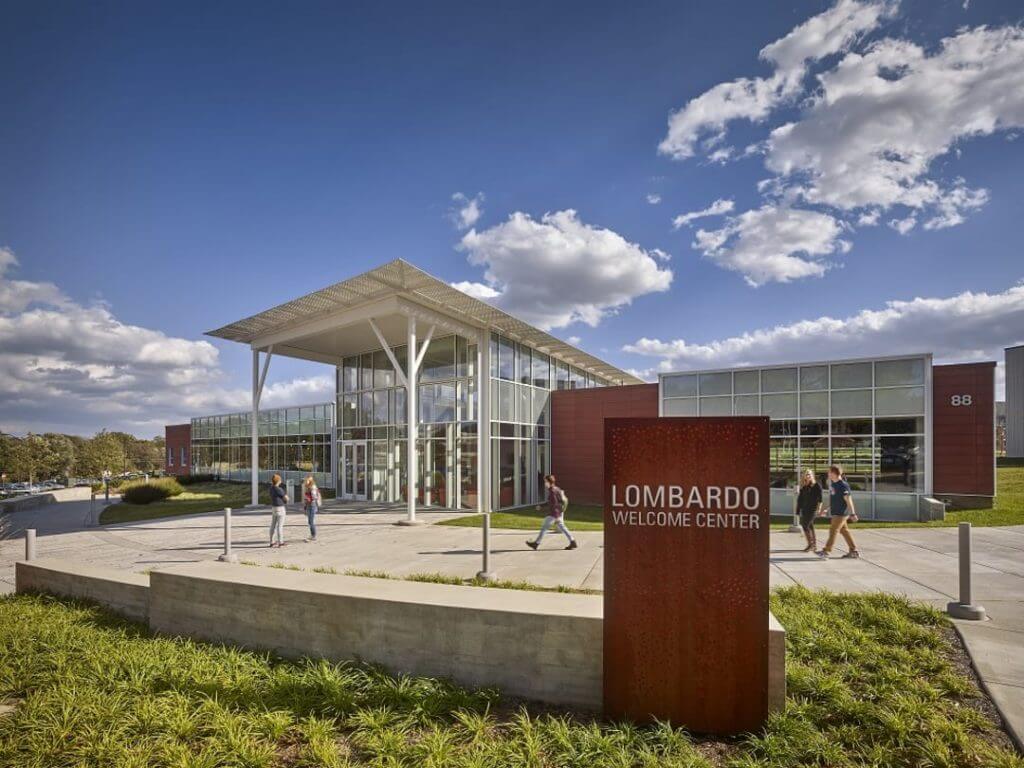The Lombardo Welcome Center at Millersville University is one of the few first International Living Future Institute-certified zero energy building in the country. ©HALKIN MASON PHOTOGRAPHY
Sustainable projects are often attractive because they offer benefits to the environment, increase building life cycle, and conserve energy. But during the current pandemic, they’re even more front-and-center since owners are realizing the impact that incorporating sustainable design and materials into their projects has on the environment and occupant health.
Industry Standard Contracts for Green Projects
The first step to get your green project off to a great start is by using the most suitable sustainable document based on your project delivery method. AIA Contract Documents offers Sustainable Projects contract documents specifically for this purpose that outline the steps required to implement a sustainable project. These exhibits and scopes of service attach to contracts for several project delivery methods, including:
- Design-build
- Design-bid-build
- Construction Manager as Constructor
- Construction Manager as Advisor
Regardless of the delivery method selected, these documents orient the parties to the sustainable project via a workshop, which should be held as early in the design process as possible, during which project participants discuss the sustainable design features for the project. Following the workshop, the architect or consultant develops a sustainability plan for the owner’s approval that outlines sustainable measures necessary to achieve the sustainable objective. The sustainability plan allocates responsibility for each sustainable measure – a specific design or construction element, or post-occupancy use, operation, maintenance or monitoring requirement – to a particular project participant. In addition, the sustainability plan details responsibilities for sustainability documentation required for the project, implementation strategies to achieve the sustainable objective, and design reviews, testing, or metrics to verify achievement of each sustainable measure.
The Role of a Sustainable Consultant
Many owners are shifting traditional sustainability coordination efforts from Architects of Record to Consultants who specialize in sustainability and may or may not be architects. The C204™, Standard Form of Consultant’s Services: Sustainable Project Services is drafted for such a specialist who implements the many stages of the sustainability process. This scope of services document provides the Sustainability Consultant with a clear blueprint to follow from start to finish.
The C204 presumes that an owner pursuing a sustainable project has, or will, execute an E204™, Sustainable Projects Exhibit with the Architect of Record. When both C204 and E204 are used on a project, the owner must edit E204 to address the consultant’s role and eliminate overlap with the architect’s role. E204 defines key sustainable terms, and C204 references these definitions.
E204 and C204 are both suitable on design-bid-build projects. For construction management and design-build projects, AIA Contract Documents offers similar sustainable projects exhibits.
CM and Sustainable Projects
With regard to the Construction Manager as Constructor (CMc) delivery method, E234 addresses the same considerations as E204, but accounts for the Construction Manager’s unique role in the predesign phase – in addition to the construction phase. Early involvement of the CMc can be valuable at the sustainability workshop because the CMc can provide input on the sustainable measures contemplated, assist in developing the sustainability plan, procure items with longer lead times, and offer experience on using certain new products developed for sustainable projects – all of which provide a smooth transition when it is time to start construction. During construction, the CMc’s responsibilities are virtually the same as the contractor’s responsibilities in E204.
In a Construction Manager as Advisor (CMa) delivery model, E235 provides that the CMa works closely with the owner and architect during preconstruction and maintains additional responsibilities during construction. During preconstruction, the CMa reviews the sustainability plan and offers advice on constructability, materials availability, time requirements for procurement, life cycle data, and analyzes any cost and schedule impacts.
During construction, the CMa coordinates the multiple prime contractors and the performance of their sustainable measures, collects their Sustainability Documentation, and responds to the architect’s requests for information from the certifying authority.
New Sustainable Projects Guide – Free Tool
Lastly, additional guidance for working on a sustainable project can be found in the updated Sustainable Projects Guide with a primary focus on the roles and responsibilities of the owner, architect, and contractor regarding sustainable design and construction projects. The guide details a variety of sustainable topics, discusses how to develop a sustainability plan based on a particular certification system, and presents an in-depth commentary about each provision in E204. Additionally, the guide addresses current topics, such as materials transparency; resilience; environmental product labels and certification systems; and jurisdictional requirements relevant to sustainable projects.
AIA Contract Documents has provided this article for general informational purposes only. The information provided is not legal opinion or legal advice and does not create an attorney-client relationship of any kind. This article is also not intended to provide guidance as to how project parties should interpret their specific contracts or resolve contract disputes, as those decisions will need to be made in consultation with legal counsel, insurance counsel, and other professionals, and based upon a multitude of factors.

